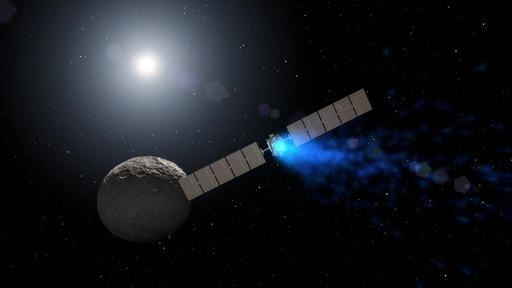ICE HIDDEN IN SHADOWY CRATERS
ON DWARF PLANET CERES
by ALICIA CHANG, AP Science Writer
 |
| This artist rendering by NASA shows the Dawn spacecraft orbiting the dwarf planet Ceres. New findings presented at the American Geophysical Union meeting on Thursday, Dec. 15, 2016 show that ice can exist in permanently shadowed craters on Ceres and is widespread below the surface. Dawn has been studying Ceres since 2015 after a stop at the asteroid Vesta. (NASA via AP) |
LOS ANGELES (AP) — Several shadowy craters on the dwarf planet Ceres contain ice, scientists reported Thursday.
Deposits of ice have previously been spied in craters on Mercury and our moon, also in regions that are permanently in the dark.
The discovery comes from pictures taken by NASA's Dawn spacecraft, which has been in orbit for over a year around Ceres, the largest object in the asteroid belt between Mars and Jupiter.
Scientists identified more than 600 craters in the northern polar region that never receive sunlight. Of these, bright patches thought to be ice were found in just 10 places.
Such a small number is unusual and needs further study, said Thomas Platz of the Max Planck Institute for Solar System Research in Germany who published the discovery in Nature Astronomy.
Ice appears to be widespread, however, just below the surface, according to a separate study in the journal Science. Readings by an instrument on Dawn that can peer below the surface detected abundant ice especially near the poles.
It's the long-awaited confirmation of widespread underground ice that scientists have been waiting for, said Thomas Prettyman, a senior scientist at the Planetary Science Institute in New Mexico.
Both studies were presented Thursday at the American Geophysical Union meeting in San Francisco.
Powered by ion propulsion, Dawn is the first spacecraft to orbit two celestial bodies to better understand how the solar system evolved. It previously visited the asteroid Vesta, beaming back tens of thousands of pictures of the dry and rugged world.
Dawn has been studying Ceres from various altitudes, getting as close as 235 miles (378 kilometers), the distance of the International Space Station above Earth. It previously spotted an inactive volcano on the surface of Ceres.
Dawn wrapped up its prime mission this past summer and is currently on bonus time.
Copyright 2016 The Associated Press. All rights reserved.
This material may not be published, broadcast, rewritten or redistributed.
Page created on 12/16/2016 12:54:41 PM
Last edited 12/16/2016 12:54:41 PM
The beliefs, viewpoints and opinions expressed in this hero submission on the website are those of the author and do not necessarily reflect the beliefs, viewpoints and opinions of The MY HERO Project and its staff.


